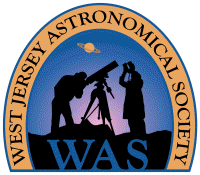| Weather Links |
Mercury 2023 |
Venus and the Crescent Moon
December 9, 2023
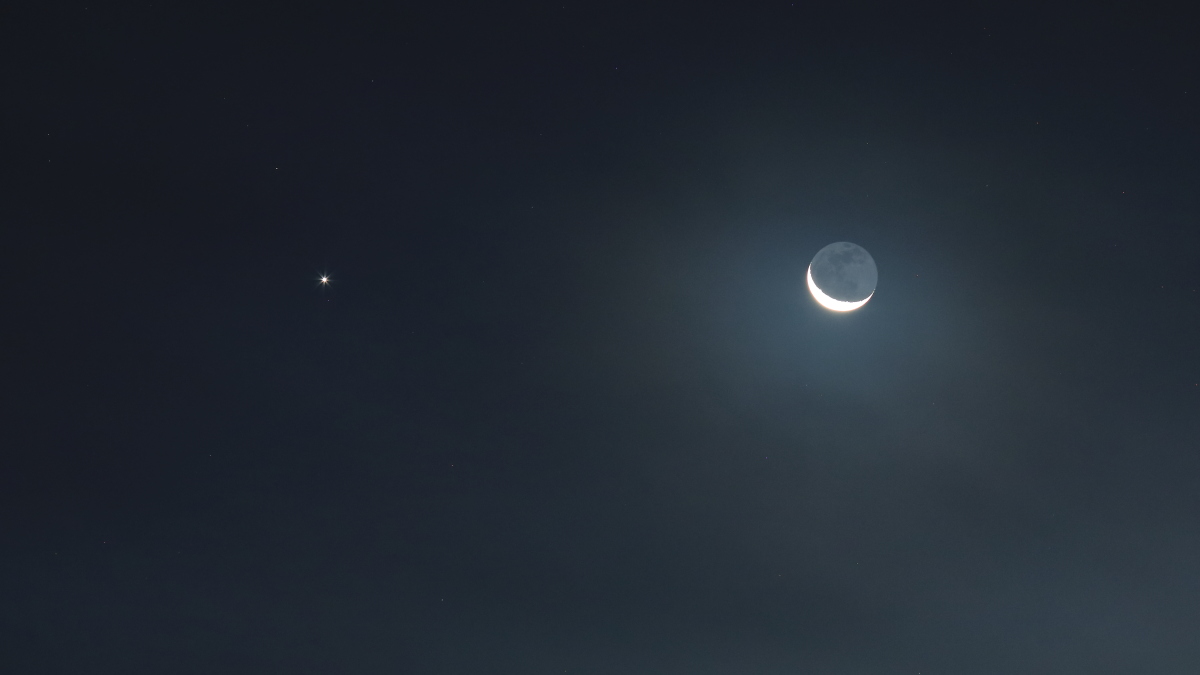
|
The waning Crescent Moon
joined Venus
on the morning of
December 9, 2023, when this snapshot of them
was captured from Marter Ave in Mt Laurel, NJ.
This is a single frame taken at 4:20 am EST, 72
minutes before the start of astronomical twilight when the two
rising objects were 3.8° apart (center-to-center) at 7.2°
altitude in a hazy sky with some ground-level fogginess. The
dimmer star above-left of Venus is magnitude 4.2 Kappa Virginis.
Taken with a Canon EOS RP DSLM camera and a Canon 200 mm f/2.8L
telephoto lens on a fixed tripod. It was exposed 1 second at
f/4.0, ISO 1600, tungsten white balance. Minimal processing was
applied, and it was cropped to a 16:9 ratio (83% x 70% of the
original linear dimensions) using Canon's Digital
Photo Professional 4 producing a field 8.6° wide x 4.8° high. At
the time, the Moon was 30.6 arc minutes diameter, 13.6%
illuminated; Venus was 16.2 arc seconds diameter, 70.7%
illuminated.
The picture above was taken to emphasize Venus and the Moon's
earthshine, allowing severe overexposure of the illuminated
crescent. The picture below was taken at 4:11 am with the same
equipment, but with reduced exposure to more properly show the
illuminated crescent: 1/250 second at f/5.6, ISO 1600, or nine
(9) stops less than the picture above. It was unprocessed,
except (using DPP4) conversion to monochrome and cropping to 12% of the
original linear
dimensions of the frame (maintaining the 3:2 ratio) for
a field 1.2° wide x 0.8° high. The Moon was then at 5.6°
altitude. |
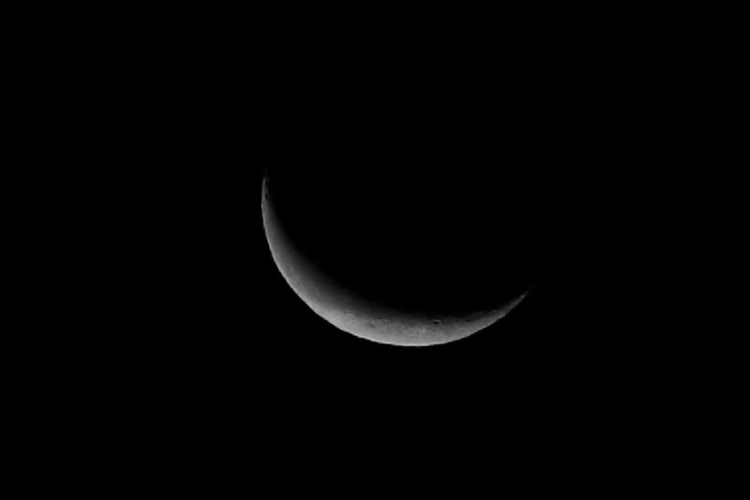
The Moon and Jupiter
November 25, 2023
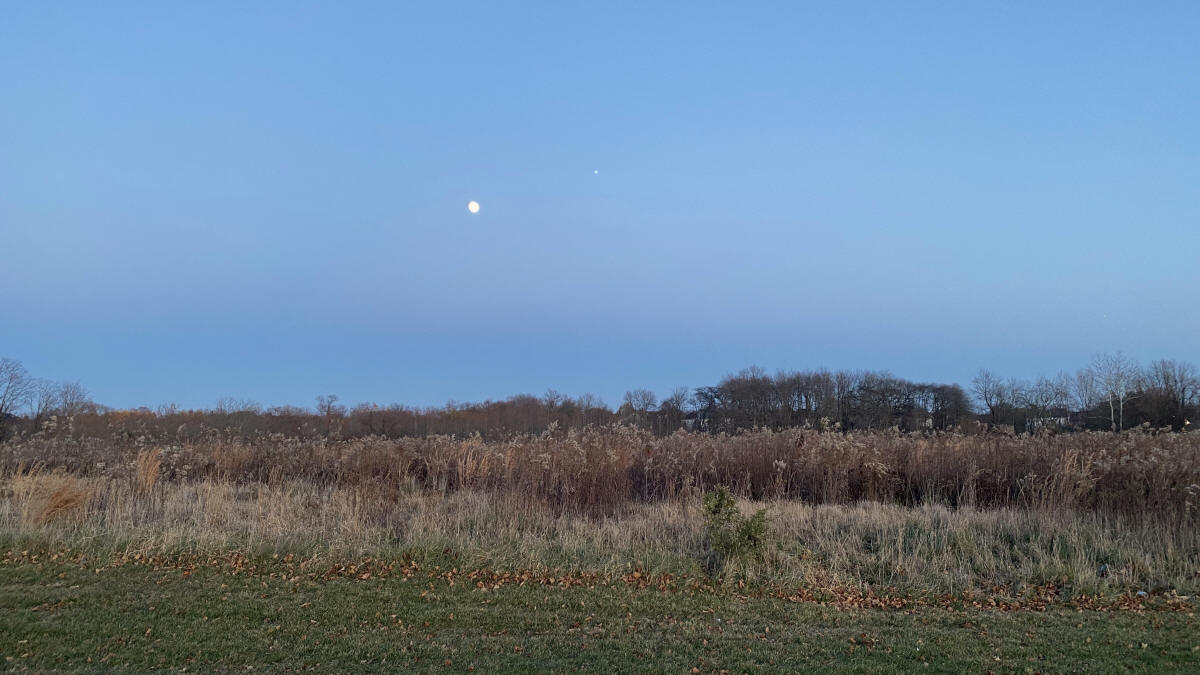
|
The rising, nearly-full Moon
was close to Jupiter
on
November 25, 2023, when this snapshot of them
was captured from Swede Run in Moorestown, NJ.
This is a single frame taken at 4:46 pm EST, 9
minutes after sunset at 4:37 pm, with a handheld iPhone 11. It was exposed
1/83 second at f/1.8, ISO 125. A piece of foreground trash was
erased and it was cropped to a 16:9 ratio in MS Photos, then
mildly adjusted with Adobe Photoshop Elements (Jupiter's
brightness was selectively enhanced). At the time, the Moon was
at 79° azimuth (≈ENE), 14° altitude and 8° east of Jupiter. It
was 97.5% illuminated, 1.5 days before Full Moon on Nov 27 at
4:16 am. The darker horizontal band along the treetops is the
earth's rising shadow and the slightly pinkish band along its
upper edge is the
Belt of Venus.
Mouseover for labels. Just after taking this picture, I
headed to nearby Bishops Gate in Mt Laurel and
spotted
Mercury. |
Comet C/2023 H2 (Lemmon)
November 12, 2023
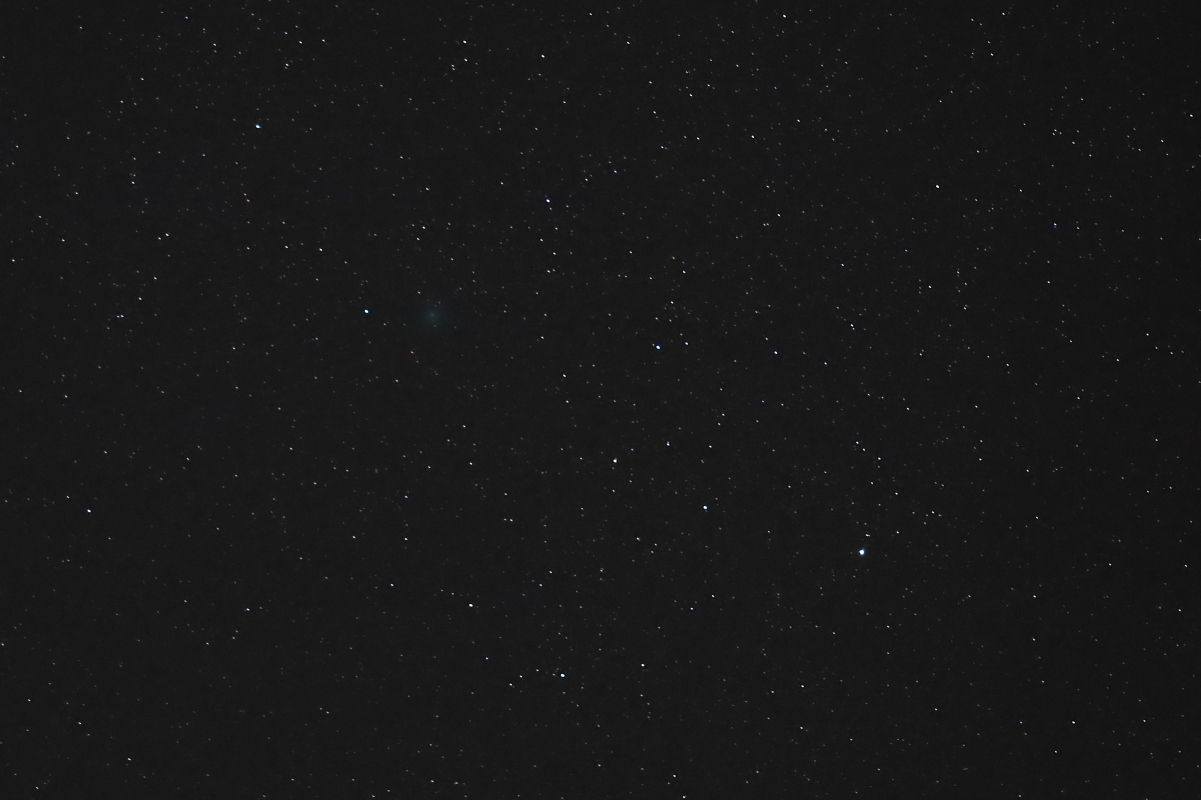
|
This snapshot of
Comet C/2023 H2 (Lemmon) was was captured on
November 12, 2023, from the Barnegat Road
Observing Site in Greenwood Forest
WMA in the New Jersey Pines. That evening, Lemmon was was an
easy target with 12x50 binoculars and an 88 mm spotting scope.
The motion against the background sky, about 0.4° per hour, was
also readily apparent (it passed closest to earth on November
10, about 0.193 au or 28.8 million km away; on November 12, it
was about 0.206 au or 30.8 million km away). The concurrent
brightness estimates at COBS
were in the magnitude 6.x range. While examining Lemmon with the
88 mm scope at 60x, I thought I saw a thin, extremely
vague tail extending about a third to halfway up and parallel to
a line between the stars HD 184663 and HD 185423, but I suspect
it was just an illusion.
This
image is a single raw frame taken at 6:15 pm EST, two minutes
before the end of astronomical twilight, with a Canon EOS RP
DSLM camera and a Canon 200 mm f/2.8L lens on a fixed tripod. It
was exposed 2 seconds at f/2.8, ISO 6400. The image was mildly adjusted
in Canon's Digital Photo Professional 4, then the white balance
was set to 4500 K and it was cropped to 51% of the original
linear dimensions for a field 5.3° wide x 3.5° high. The comet was at
43° altitude.
Mouseover for labels. |
The
Crescent Moon and Comet 2P/Encke
October 12, 2023
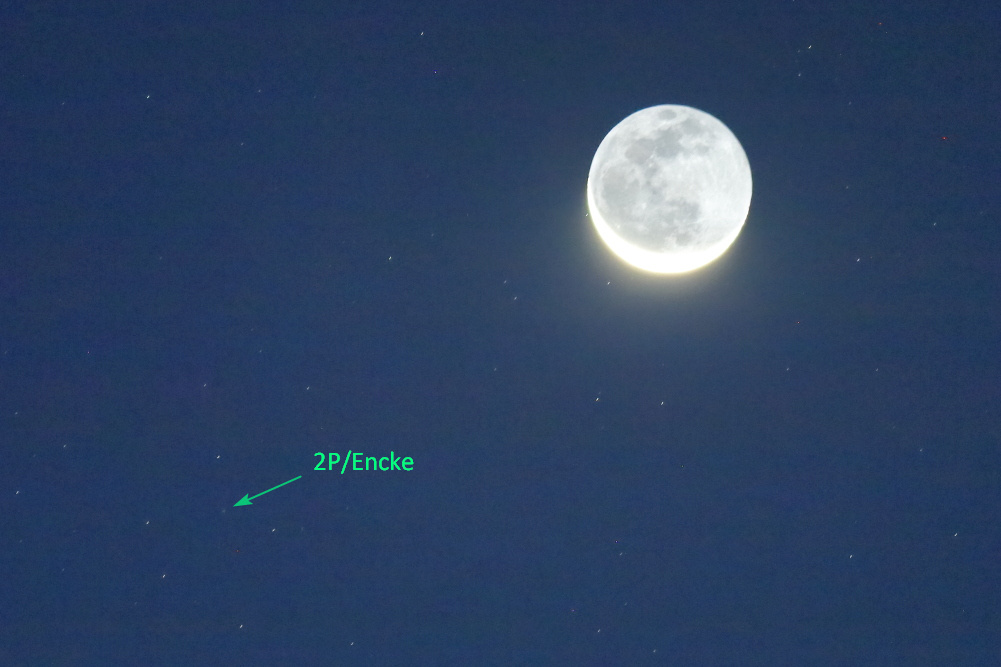
|
This is the earthshine-filled
Crescent Moon,
captured on
October 12, 2023,
at 5:59 am EDT from Wharton State Forest, NJ, when it was 4.8% illuminated
and two days before it will eclipse the sun on October 14,
an annular eclipse,
but only partial in the Delaware Valley area. The thin
crescent with obvious earthshine was a lovely sight to the
unaided eye, but it was also close to periodic comet
2P/Encke, as labeled in this image (visible in a telescope).
The two objects were 1.7° apart, center-to-center, in
western
Virgo, near Nu Vir, close to the Leo border; the Moon was at 11.7° altitude and
2P/Encke
was at 10.5° altitude. 2P was easily seen visually in a
12.5-inch Dob at 5:35 am after initially spotting it on the camera's
viewing screen a few minutes earlier. Because of the low altitude and nearby Moon, I
didn't think it would be visible, so I didn't look with my 88 mm
spotting scope before I replaced it with the camera on the
gimbal mount used for both instruments. The Moon rose at 4:53 am and
2P/Encke
rose at 5:02 am.
This image is from a single raw frame taken with a Canon EOS RP
DSLM camera and a Canon 400 mm, f/5.6L
telephoto lens. It was manually exposed 2
seconds at f/5.6, ISO 1600, auto white balance. Using Canon's
Digital Photo Professional 4, the exposure was increased by 2.5
stops to bring out the comet, along with the blue color of the
sky (23 minutes after the start of astronomical twilight at 5:36
am) resulting in a vastly overexposed Moon.
Mouseover to see
the original, unprocessed image. The original was cropped
with DPP4 to 58% of the original linear dimensions for a field
3.0° wide x 2.0° high. Here's a
similar shot taken from Utah on October 12 (MDT, so probably
a couple of hours later; notice the change in both 2P's and the
Moon's positions with respect to the field stars).
While at Wharton SF on the morning of Oct 12, two other comets
were observed,
103P/Hartley
was faint, but distinctly visible
near the Eskimo Nebula (NGC 2392) in
Gemini (I think I might have seen a slight coma
extension in the expected tail direction).
C/2023 H2
(Lemmon) was very faint near M106 in
Canes Venatici (here's an
APOD of it on Oct 12). Each of these two comets was seen with both the 12.5-inch Dob and
an 88 mm spotting scope. About 30 hours earlier, late on the
evening of Oct 10, comet 12P/Pons-Brooks was observed with the
12.5-inch from the same site. Here's a composite image
showing the evolution of 12P's outburst coma. |
Comet C/2023 P1 (Nishimura) and M44, The Beehive Cluster
September 1, 2023
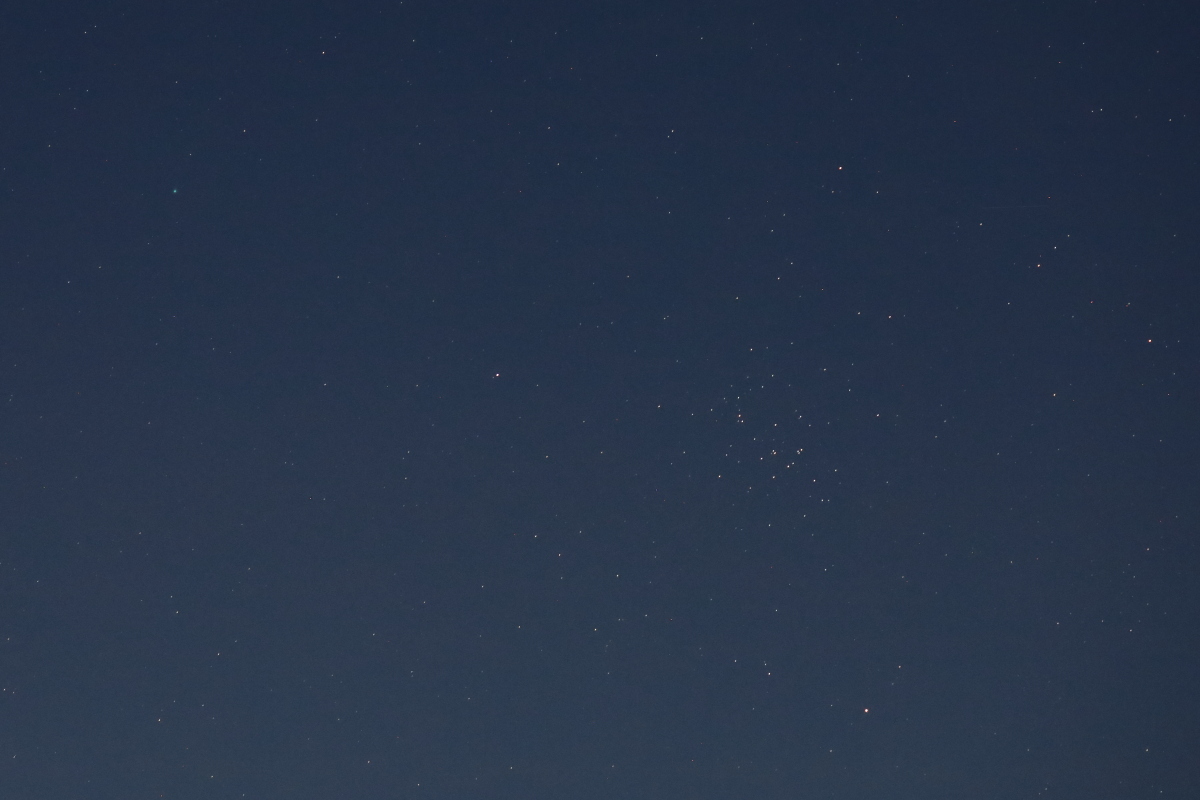
|
Comet C/2023 P1 (Nishimura) was discovered
on August 12, 2023. My first visual sighting of it was on August
19. On
September 1, 2023, I made my fifth
sighting and captured my first snapshot, all from Wharton State
Forest in the NJ Pines. On Aug 19, the comet was a dim patch of
haze in my 115 mm spotting scope, but on Sept 1, when it was
near
Messier 44, the
Beehive Cluster in
Cancer, it was an
obvious diffuse object with the 115 mm scope, perhaps showing a tinge
of greenish color.
It was also seen with 15x56 binoculars on Sept 1.
Contemporaneous
estimates at COBS were around magnitude 7.
This image is a single raw frame taken at 5:10 am EDT, 19
minutes after the start of astronomical twilight, with a Canon
EOS RP DSLM camera and a Canon 200 mm f/2.8L lens on a fixed
tripod. It was exposed 2 seconds at f/4.0, ISO 3200. The image
was mildly adjusted in Canon's Digital Photo Professional 4,
setting the white balance to 5800 K and cropping it to 76% of
the original linear dimensions for a field 7.8° wide x 5.2°
high.
At the time it was taken, there was a 97.5% illuminated Moon at
30° altitude in the southwest; the comet was at 16.4° altitude
in the east-northeast.
Mouseover for labels. |
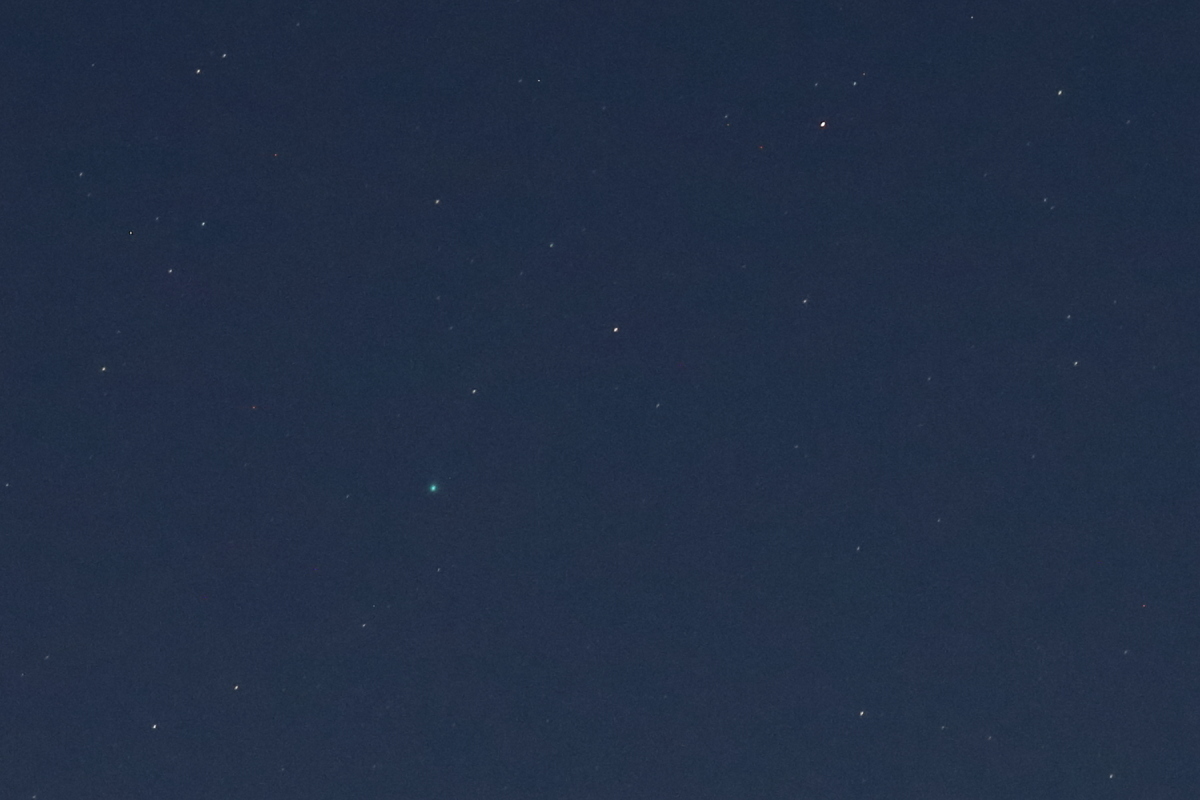
|
This is the same frame as the image above,
except a deeper crop of the upper-left quadrant to better show
C/2023 P1 (Nishimura)
and its color. It's 29% of the original linear dimensions for a
field 3.0° wide x 2.0° high. Star magnitudes are from
SkyTools 4. Mouseover for labels. |
The
Crescent Moon and the Crescent Venus
July 24, 2023
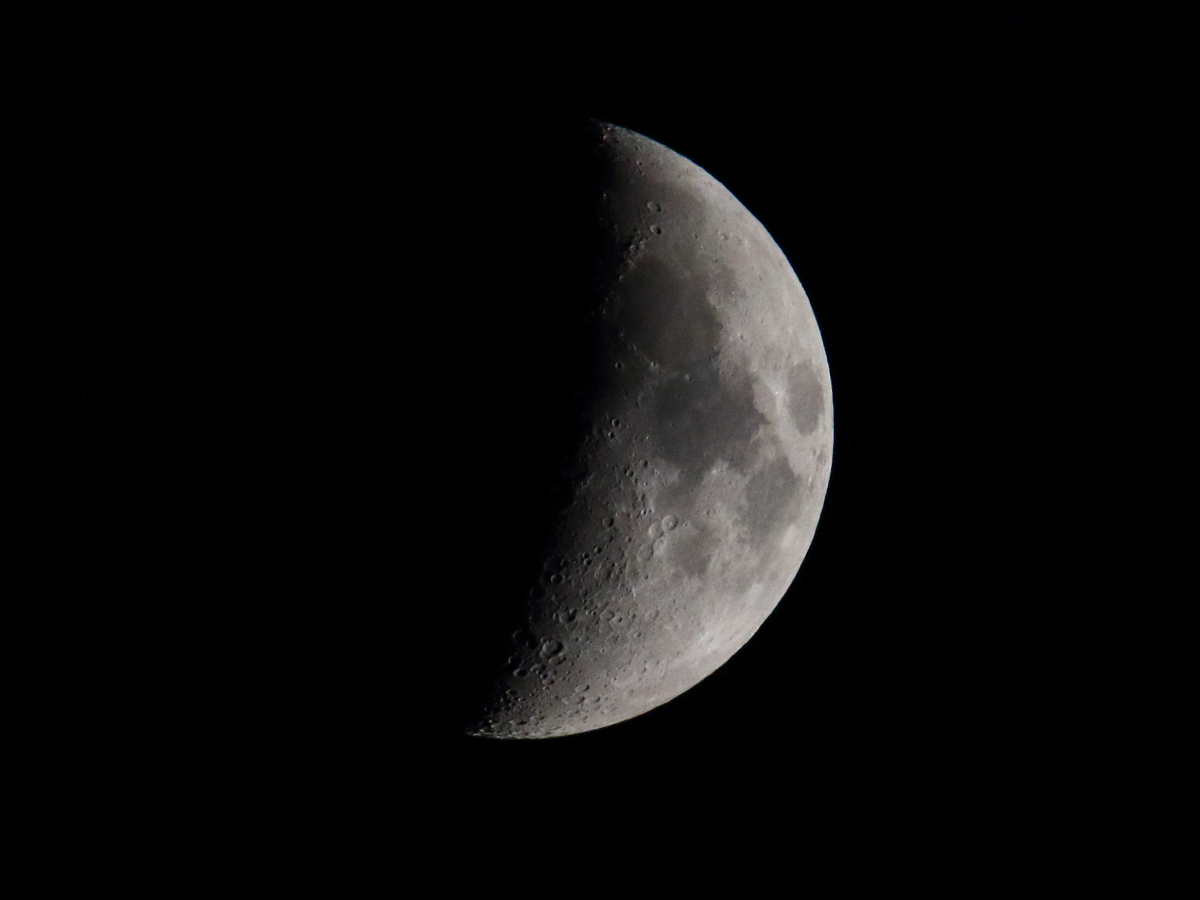
|
On
July 24, 2023, the 7.3 day old, thick
Crescent Moon,
41% illuminated, was captured from Bishops Gate in Mt
Laurel, NJ. This is a single raw frame taken at 8:49 pm EDT with
a Canon 7D Mark II DSLR camera and a Tamron 150 to 600 mm, f/5.0
to 6.3, zoom lens set to 600 mm focal length. It was exposed
1/1600 second at f/11, ISO 3200 (one stop more than the "Looney
Eleven" rule-of-thumb for a Full Moon). It was mildly adjusted
in Canon's Digital Photo Professional 4, including setting to
auto white balance and cropping to about 46% of the original
dimensions for a field 1.50° wide x 1.13° high (a 4:3 ratio). |
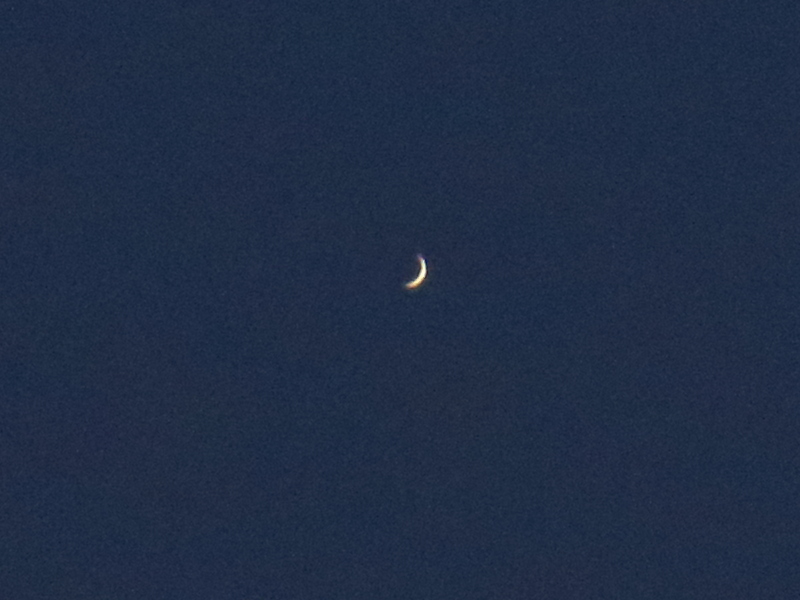
|
This is the
Crescent Venus,
11.3% illuminated, on
July 24, 2023, as observed from Bishops Gate in
Mt Laurel, NJ, at 8:25 pm EDT, 4 minutes after sunset when Venus
was at 10° altitude.
At the time, Venus was 48.8″ apparent diameter
and 26.9° solar elongation as it sinks in the west after sunset
heading towards
inferior conjunction with the sun on
August 13,
2023. The shape looks remarkably similar to the 9.3%
Crescent Moon in the picture below, although the Moon's apparent
diameter is 36x greater.
It's a single raw frame taken with a Canon
7D Mark II DSLR camera and a Tamron 150 to 600 mm, f/5.0 to 6.3,
zoom lens set to 600 mm focal length. It was exposed 1/1000
second at f/16, ISO 3200. It was set to 4200 K white balance and
cropped to about 15% of the original dimensions for a field
0.50° wide x 0.38° high (4:3 ratio) using Canon's Digital Photo
Professional 4. |
The
Crescent Moon and Venus
July 20, 2023
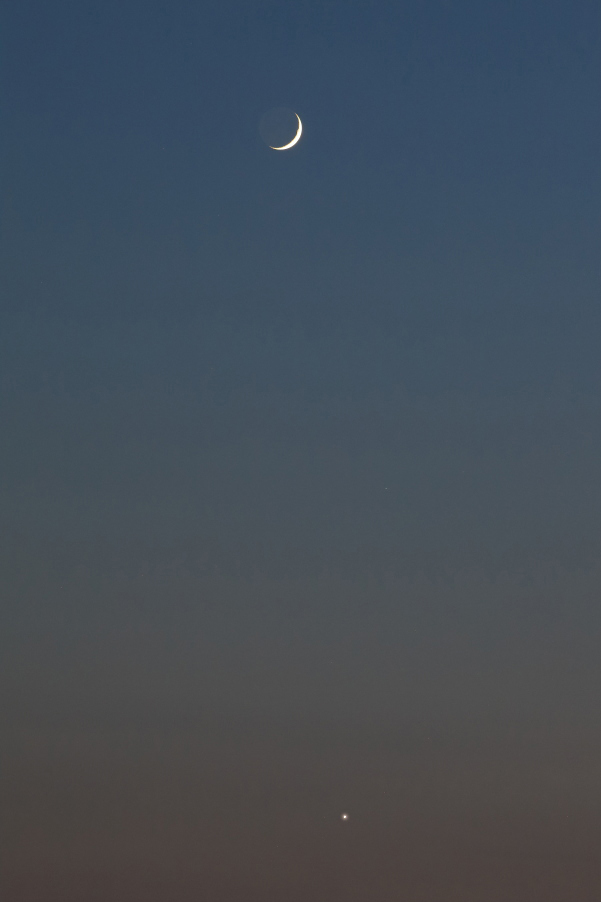
|
On
July 20, 2023, 40 minutes after sunset at 8:24
pm EDT, the
Crescent Moon
hovered 8° above the planet
Venus when
this image of them was captured from Bishops Gate in Mt
Laurel, NJ. The dim planets
Mars, about
4° left of the Moon, and
Mercury,
about 11½° to the right of Venus, were spotted visually with
optical aide but are not visible in the image. Mouseover for
labels.
Taken at
9:04 pm with a Canon EOS RP DSLM camera and a Canon 200 mm
f/2.8L telephoto lens on a fixed tripod. It was exposed
1/6 second at f/5.6, ISO 1600 (automatic minus 2/3 stop) with
auto white priority. It's unprocessed, except for eliminating a
dust mote and preferentially brightening Venus a little with
Adobe Photoshop Elements. It's uncropped for a field 6.9° wide x
10.3° high.
At the time, the 29′35″ apparent diameter
Moon was a 9.3% illuminated crescent, 3.3 days after New Moon on
July 17 at 2:32 pm EDT.
Venus was also a crescent, 14.8% illuminated but only 46 arc-sec
diameter (about three-quarters of an arc-min), so the crescent
doesn't show in this image, but it was a splendid sight in an 88
mm spotting scope at 25 to 60x. |
Sunset at Bishops Gate
July 2, 2023
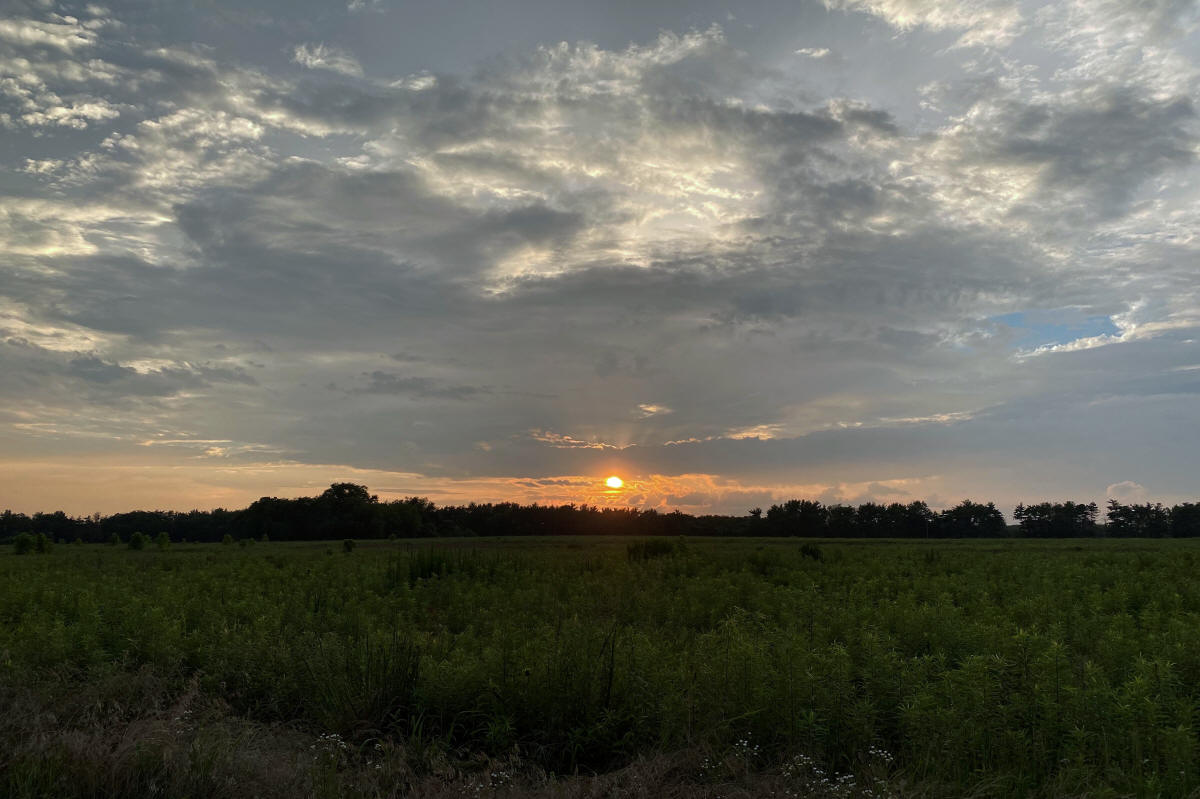
|
On
July 2, 2023, I went to Bishops Gate in Mt
Laurel, NJ, to
look for Mercury towards sunset at 8:32 pm EDT.
Mercury was only 2.6° above the sun, but quite bright at
magnitude –2.0, just 1.8 days after superior conjunction when
Mercury is "full," so it wasn't beyond the realm of possibility.
Alas, the clouds shrouding the sinking sun precluded a sighting
(scanning with an 88 mm spotting scope at 25x). Taken at 8:05
pm, when the sun was at 4.1° altitude, using a handheld iPhone
11 with automatic settings (1/1604 second, f/1.8, ISO 32, 4.25
mm focal length). While there, I did see Venus, which showed a
nice thinning crescent with the 88 mm scope, especially at 60x.
As I was leaving, the somewhat ruddy full moon appeared
briefly through a cloud gap in the direction opposite this view
of the sun. |
Some Double Stars in Lyra
June 14, 2023
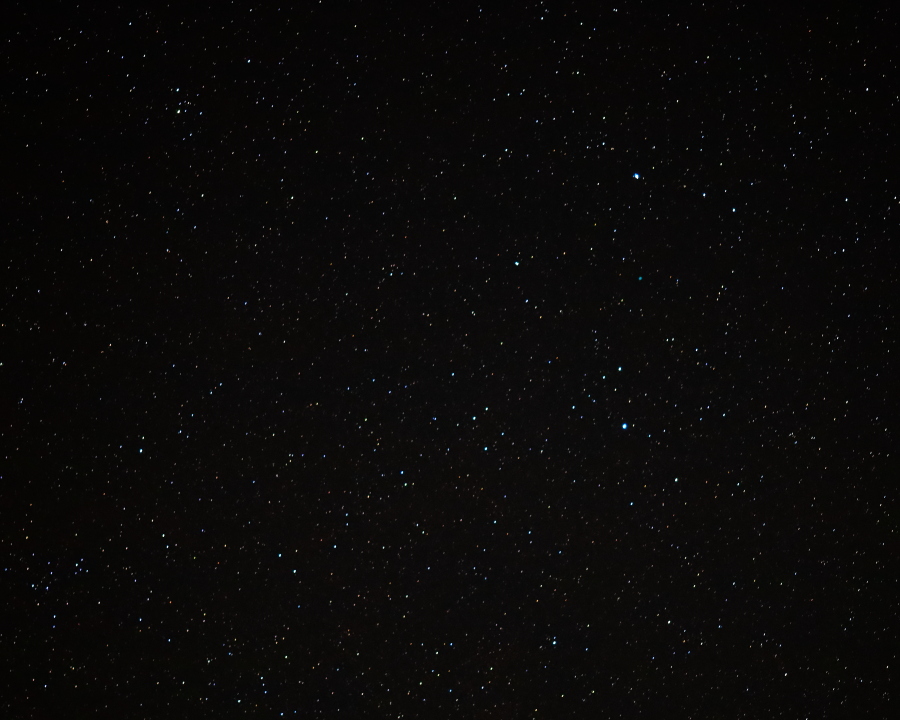
|
Here's another snapshot on
June 14, 2023, taken from Atsion at 11:03 pm EDT
with a Canon EOS RP DSLM and a Canon 200 mm f/2.8L lens on a
fixed tripod. It's a single raw frame exposed 4 seconds at f/2.8,
ISO 6400, 4600K white balance. The raw image was cropped to
a 5:4 ratio, about 67% x 81% of the original dimensions for a field
6.9° wide x 5.6° high, mildly adjusted then converted to a JPEG
in Canon's Digital Photo Professional 4.
Everyone is familiar with
Epsilon Lyrae,
the famous
Double Double, and perhaps even the nice pair
Zeta 1 & 2 Lyr,
STFA 38 AD. These two doubles form
a nearly equilateral triangle with Vega, nominally 2° on a side,
such that at first glance, the Epsilon and Zeta pairs can be
confused with each other while searching (neither are present in this image).
However, here are two other interesting pairs, the first is
SHJ 282 AC, which is a junior
Albireo
(color contrast double)
near the base of the Lyra parallelogram, about a degree north of
the well-known Ring Nebula, M57. It's a mag 6.0+7.6 yellow and pale blue pair with a 45" separation. The
primary is also a double,
OΣ 525 AB, mag 6.0+9.3 with a 1.8"
separation, so at best, it would be a challenging split under NJ skies. (SHJ = South & J.Herschel, OΣ = O.Struve)
The other is the Double-Double's Double,
Σ 2470 & Σ 2474,
about 3° northeast of Sulifat at the southeast corner of the
Lyra parallelogram (Σ = F.G.W.Struve). The two pairs are about
10 arc minutes apart.
Σ 2470 AB is
mag 7.0+8.4, 13.8", 267° PA, pale yellow.
Σ 2474 AB is mag 6.8+7.9, 16.0", 263° PA, blue-white.
They are indeed closely matched in magnitude, separation and
position angle, visually showing just a mild color difference. |
Rho Ophiuchi, the Star(s)
June 14, 2023
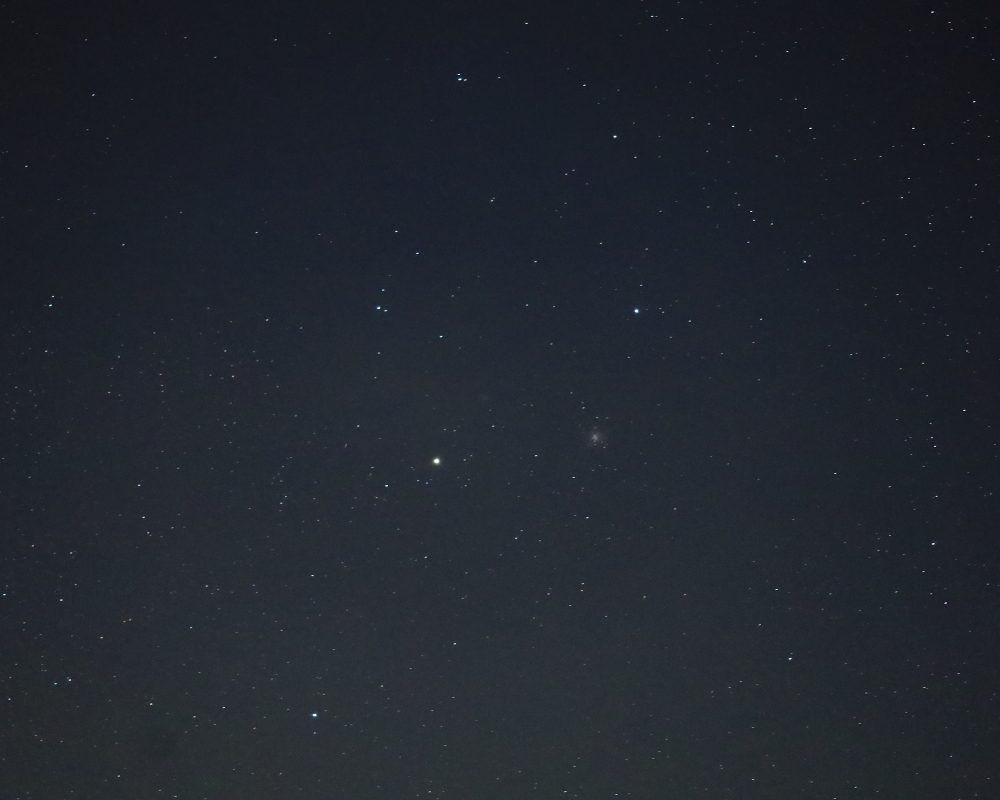
|
While it's best known for it's association with vivid nebulosity
in deep-sky images,
Rho Ophiuchi
is a fascinating
multiple star in its own right. This non-nebulous snapshot
of it was captured at 11:05 pm EDT on
June 14, 2023, from Atsion Field
in Wharton State Forest, NJ. It was taken with a Canon
EOS RP DSLM and a Canon 200 mm f/2.8L telephoto lens on a fixed
tripod. It's a single raw frame manually exposed 4 seconds at f/2.8,
ISO 6400 and 3800K white balance. Using Canon's Digital Photo
Professional 4, the raw image was mildly adjusted then cropped to
a 5:4 ratio, about 77% x 92% of the original dimensions, for a field
7.9° wide x 6.3° high. Mouseover for labels.
Visually in a small telescope, even at modest magnification, Rho
A, C, and D make a compact right angle with A at the corner. As
is visible at the top of this image, C is above A and D is right
of A. The separation of both AC and AD is about 2.5 arc minutes,
which I have resolved with 10x42 binoculars resting on top of a
tripod.
With higher magnification, and/or a larger scope, the tight AB
pair, 3 arc seconds separation, can be resolved with B at a
position angle of about 334° (towards the 1 o'clock position in
this view with north at the 11:30 o'clock position). That's far
too close to resolve in this photo, but I have resolved it
visually with optics my 88 mm (3.5 inch) spotting scope at 96x.
The southern border of the constellation
Ophiuchus is along the northern border of
Scorpius. Rho ( ρ ) Oph
is near the southern border of Ophiuchus, just 3° north of Antares, Alpha ( α ) Sco.
At a declination of 23.5°S, it transits at ~27° altitude for
Southern New Jersey. |
Supernova 2023ixf in M101
June 14, 2023
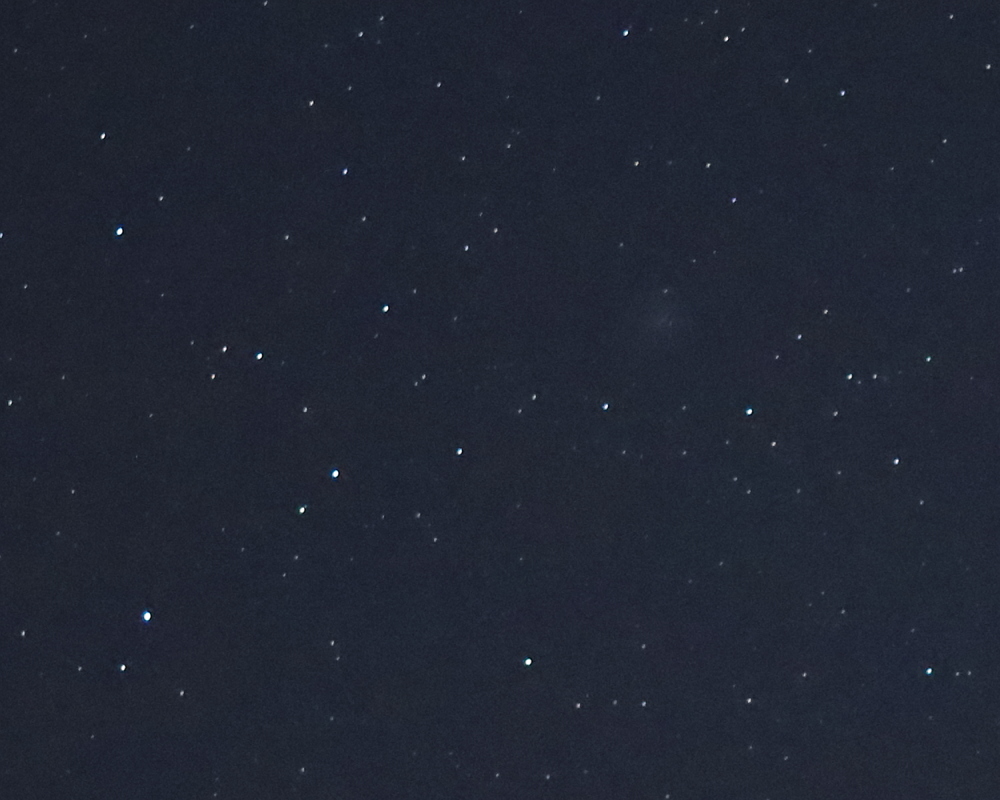
|
It's been almost a month since
Supernova 2023ixf
was discovered in
M101, the Pinwheel Galaxy. This snapshot of them was
captured under a moonless sky at 10:59 pm EDT on
June 14, 2023, from Atsion Field
in Wharton State Forest, NJ. It was taken with a Canon EOS RP DSLM and a
Canon 200 mm f/2.8L telephoto lens on a fixed tripod. It's a single raw frame
manually exposed 3.2 seconds at f/2.8,
ISO 6400 and 3800K white balance. Using Canon's Digital Photo
Professional 4, the raw image was mildly adjusted then cropped to
a 5:4 ratio, about 24% x 29% of the original dimensions, for a field
2.5° wide x 2.0° high. Mouseover for labels.
This was the ninth date I've observed
SN 2023ixf since it's
discovery on May 19, 2023 (observed on May 21, 22, 23, 25.
27, 28, 31, June 10 and 14), using 88 mm (3.5") and 115 mm
(4.5") spotting scopes, and a 12.5" Dob. I have not
been successful seeing it with 15x56 binoculars. June 14 was the first
time I attempted a snapshot.
I am not even close to being an
accomplished magnitude estimator, but the May dates I put it at mag 11, and now as we approach the middle of June, mag 11.5.
This has corresponded reasonably well with
visual estimates at the AAVSO. SN 2023ixf
has become a popular target because reaching a nominal magnitude 11
peak, it's much brighter
than the typical supernova and is located in a well-known galaxy,
so it's readily accessible to visual observers with modest-sized
telescopes.
I subsequently observed SN 2023ixf on June 17, 2023, sighting
#10, at Batsto in Wharton State Forest with the 115 mm and 12.5"
scopes. It was becoming a little tougher to see with the 115 mm,
but still relatively easy with the 12.5". The latter also showed
some spiral arm structure in M101 vs. being a mere haze in the
115 mm.
On the evening of June 28, 2023, I
went to Atsion for some general observing. Although the Moon was
bright when I left home, encroaching cloud cover dimmed it on
the way down, so it was mostly cloudy when I arrived around 10
pm EDT. With a couple of other observers, we stuck it out
working sucker holes with binoculars, until about midnight when
finally cleared, although transparency wasn't ideal (still some
smoke?) worsened by the 78% Moon that was still up. I was unable
to positively identify SN 2023ixf with my 115 mm scope (it had
dropped to near magnitude 12). However, with a 12.5 inch Dob,
the SN was unambiguous and again, some of M101's spiral
structure was evident. |
Crescent Moon and Jupiter
June 14, 2023
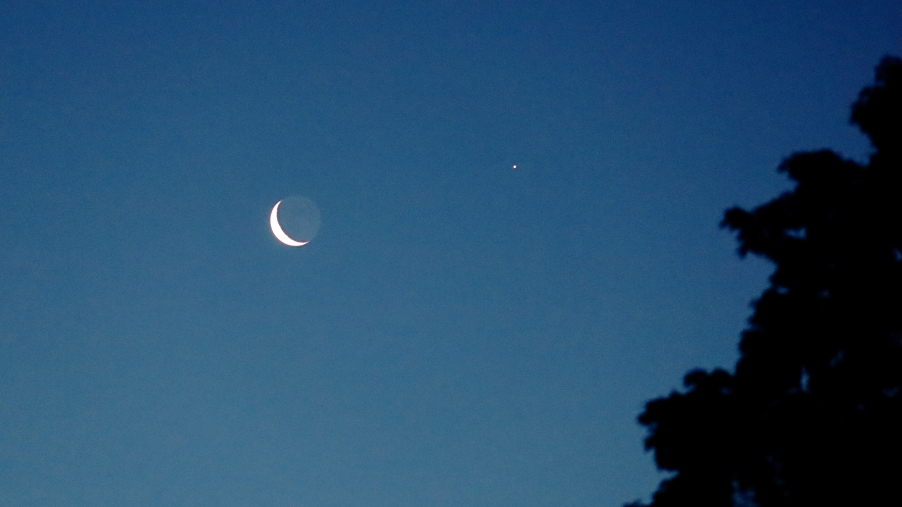
|
The waning crescent
Moon (14.5%
illuminated) was 2.4° northeast of
Jupiter on
June 14, 2023, at 4:54 am EDT as seen from my
front yard in Maple Shade, NJ. It was taken with a Canon EOS RP DSLM and a
Canon 200 mm f/2.8L lens on a fixed tripod. It's a single raw frame exposed 1/250 second at f/2.8,
ISO 10,000 and daylight white balance. The raw image was cropped to
a 16:9 ratio, about 90% x 76% of the original dimensions for a field
9.2° wide x 5.2° high, mildly adjusted then converted to a JPEG
in Canon's Digital Photo Professional 4. |
Smokey Moon
June 7, 2023
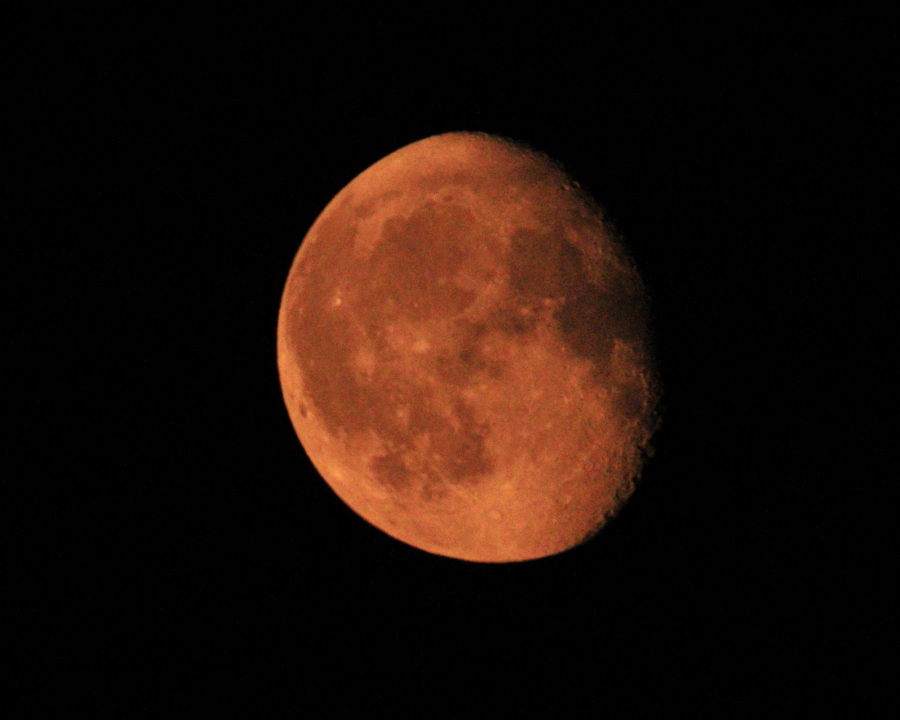
|
Here's a "smokey" waning gibbous
Moon (about 87%
illuminated three days after full) on
June 7, 2023, at 2:01 am EDT, as seen through a
thick veil of smoke that had wafted over New Jersey from forest fires
in Canada. Besides the Moon, no other celestial objects were
visible at the time. If not for the Moon, one would think there
was substantial cloud cover.
It was taken from the parking lot of the Cinnaminson (NJ) Middle
School with a Canon EOS RP DSLM and a Tamron 150 to 600 mm
f/5.0-6.3 zoom lens (on a fixed tripod) set to 600 mm focal
length. It's a single raw frame exposed 1/125 second at f/8.0,
ISO 6400 and daylight white balance (no physical filter was
used). The raw image was cropped to about 35% of the original
dimensions (to a 5:4 ratio) for a field 1.1° wide x 0.88° high,
then converted to a JPEG in Canon's Digital Photo Professional
4. The as-taken daylight color balance looked excessively orange
compared to the visual view, so the color balance here was
adjusted to 3400K to more closely resemble the visual
appearance. This camera settings, plus a half-stop increase in
brightness applied in processing, was effectively 7 stops more
exposure than the "Looney
Eleven" rule-of-thumb for the Moon. |
Click here
for the previous page.
Click here
for an index to all previous SJAstro pages.
















